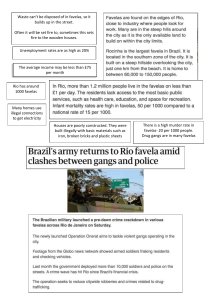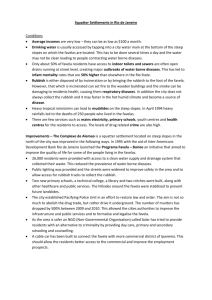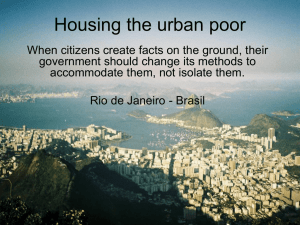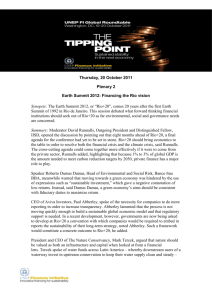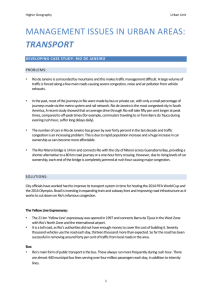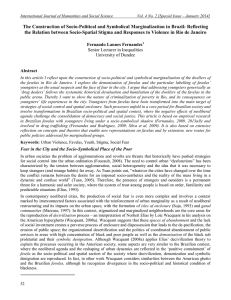Differences of Development in Rio de Janeiro An Overview Forty
advertisement
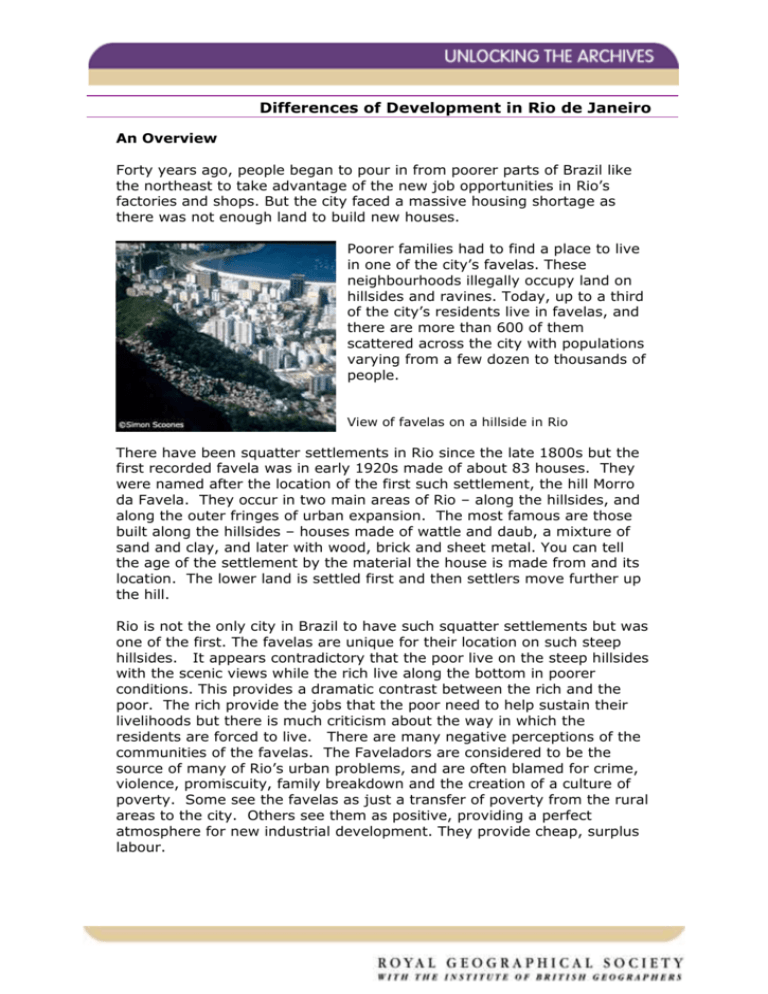
Differences of Development in Rio de Janeiro An Overview Forty years ago, people began to pour in from poorer parts of Brazil like the northeast to take advantage of the new job opportunities in Rio’s factories and shops. But the city faced a massive housing shortage as there was not enough land to build new houses. Poorer families had to find a place to live in one of the city’s favelas. These neighbourhoods illegally occupy land on hillsides and ravines. Today, up to a third of the city’s residents live in favelas, and there are more than 600 of them scattered across the city with populations varying from a few dozen to thousands of people. View of favelas on a hillside in Rio There have been squatter settlements in Rio since the late 1800s but the first recorded favela was in early 1920s made of about 83 houses. They were named after the location of the first such settlement, the hill Morro da Favela. They occur in two main areas of Rio – along the hillsides, and along the outer fringes of urban expansion. The most famous are those built along the hillsides – houses made of wattle and daub, a mixture of sand and clay, and later with wood, brick and sheet metal. You can tell the age of the settlement by the material the house is made from and its location. The lower land is settled first and then settlers move further up the hill. Rio is not the only city in Brazil to have such squatter settlements but was one of the first. The favelas are unique for their location on such steep hillsides. It appears contradictory that the poor live on the steep hillsides with the scenic views while the rich live along the bottom in poorer conditions. This provides a dramatic contrast between the rich and the poor. The rich provide the jobs that the poor need to help sustain their livelihoods but there is much criticism about the way in which the residents are forced to live. There are many negative perceptions of the communities of the favelas. The Faveladors are considered to be the source of many of Rio’s urban problems, and are often blamed for crime, violence, promiscuity, family breakdown and the creation of a culture of poverty. Some see the favelas as just a transfer of poverty from the rural areas to the city. Others see them as positive, providing a perfect atmosphere for new industrial development. They provide cheap, surplus labour. Shortage of Utilities All favelas are below the accepted standard in their access to utilities. Clean water is available only at the bottom of the hills, making access for those at the top extremely difficult. Only 50% have an inside toilet. Sewage runs through open drains collecting at the bottom of the hill creating a real health hazard. Electricity is scarce limiting the small, local industries and making life very hard work. Rubbish is burnt on the hill or brought down to the street where the authority is supposed to take it away, but this often does not happen encouraging the spread of disease. Living in the Favela Community Each favela has its own unique community with food and clothes shops, pharmacies, repair shops and small businesses. The range depends on the size of the population and the location of the favela. Goods are often far more expensive in the favela than in other parts of the city, making the local people purchase far smaller amounts and buying, where possible, on credit. Many local community groups keep constant pressure on the government to sustain and improve the favelas. One of the oldest and biggest is called Rocinha. Rocinha began in the 1940s when a group of squatters took over a hillside next to the rich downtown district of São Conrado. Since its early days, Rocinha residents have worked together to make it a decent place to live. With up to 250,000 residents, Rocinha is now more like a city within a city with its own schools, doctors’ surgeries and fast food outlets. The permanence of Rocinha is now accepted by the Brazilian government, despite the fact the land was occupied illegally. Other Ways of Life Favelas are not the only poor areas of the cities, but are generally accepted as the most deprived in terms of utilities and amenities. Their infrastructure is poorly developed and the residents are under the constant threat of homelessness. Not all of Rio de Janeiro is about poverty however. There are some fantastically rich areas as well, providing a very real contrast to the favelas and other deprived areas. Areas such as Copacabana, Ipanema, Botafago all boast a very different and up-beat feel. Such contrasts make living in the very poor areas even harder. Copacabana shares its name with the beach in front of this famous city neighbourhood. In colonial times, wealthy Portuguese plantation owners would bring their families here for a weekend outing. Today, Copacabana has a huge mixture of people with different backgrounds and paypackets. At 25,000 people per square metre, it also has one of the highest population densities in the world. With space at a premium, rich residents live in high-rise apartment blocks that line the beachfront. Many of these apartments are now holiday homes for the very rich of São Paulo. Other residents, known as ‘cariocas’ have chosen to move out to the outlying suburbs. Today, more than 130,000 people live in Barra da Tijuca, along the coast to the west. Nicknamed, the ‘Brazilian California’, families can bring up their children away from the noise, pollution and higher crime levels of downtown Rio. Barra da Tijuca has also become Rio’s newest centre for Brazilian and overseas companies that are attracted by the safer, cleaner and less crowded environment. Barra da Tijuca is Rio’s youngest neighbourhood. Building only began 40 years ago, and planners learned from the mistakes of other areas. Like an American city, Barra da Tijuca has wide avenues and roads, and large, spacious condominium complexes. The town also has South America’s largest convention centre called Riocentro. Residents have plenty to do thanks to a five kilometre strip of shops and entertainment facilities. ‘Barrashopping’ is the largest shopping mall – with over 650 shops and apartments, offices, restaurants, cinemas and even its own monorail. Barra da Tijuca also boasts five theme parks and 21 nightclubs, and the beach is Rio’s longest and cleanest stretch of sand. What’s more, residents can still reach downtown Rio within half an hour. Not everybody in Barra da Tijuca enjoys a luxurious lifestyle. New favelas like Jacarezinho (or little alligator) are springing up, home to the construction workers, maids, nannies and porters that work in Barra da Tijuca. Jacarezinho residents cannot afford the rents and house prices of the gated condominiums and have to make a home where they can. Unlike the favelas downtown that cling to the city hillsides, the flatter terrain keeps these poor neighbourhoods out of sight. But without even basic services like piped water, electricity and sewage disposal, conditions here are some of the worst in Rio.
